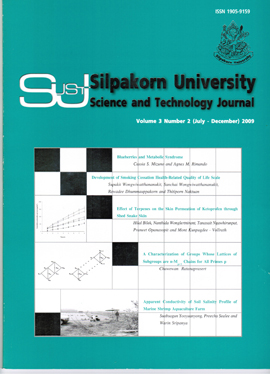Apparent Conductivity of Soil Salinity Profile of Marine Shrimp Aquaculture Farm
Main Article Content
Abstract
The Direct Current method was used to investigate the soil salinity profile of marine shrimp aquaculturefarm comparing with the rice field. Finite difference method was used with the iterative technique to minimizethe potential difference of the calculated and the measured potential to give an optimal solution rapidly. Theiterative technique of Quasi-Newton was used and found to be robust with respect to starting models for boththe synthesis and real data. The results showed the conductivities for both the rice field and the marine shrimpaquaculture farm varied between 0.15 S/m to 0.22 S/m and 0.15 S/m to 0.33 S/m, respectively. Those number ofconductivities indicated that the salt or mineral deposit in the ground from marine shrimp aquaculture farm didnot have much of an impact on the plant since the conductivity, which implied salt and mineral deposit, of theground used for growing rice should not more than 0.40 S/m. Therefore, both ranges of conductivity of theground could be used for orchard and paddy.

